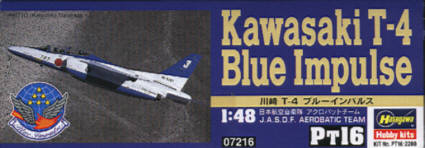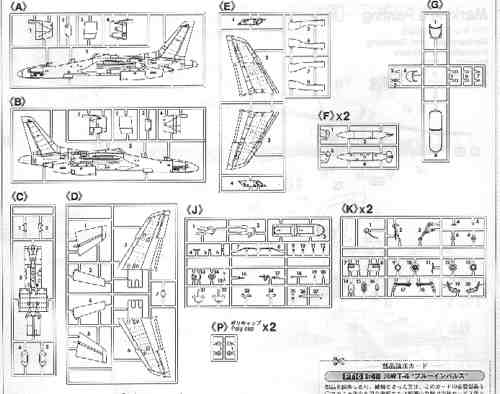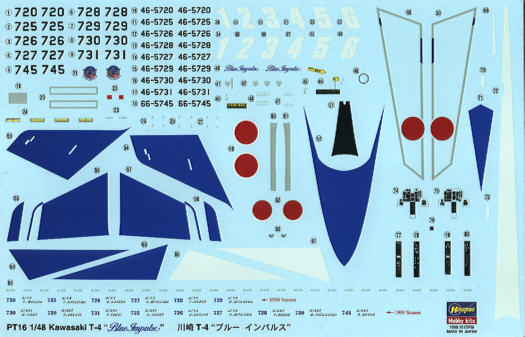
|
KIT: |
Hasegawa 1/48 Kawasaki T-4 |
|
KIT # |
PT 16 |
|
PRICE: |
$26.00 |
|
DECALS: |
JASDF Blue 'Impulse'- 96 & 99 markings |
|
REVIEW & |
|
|
NOTES: |
|

|
HISTORY |
The Kawasaki T-4 is the first all-Japanese primary jet trainer to enter service. It was also the first Japanese-designed postwar military aircraft to be manufactured using entirely Japanese-made components. The T-4 was first flown on July 27th, 1985. After entering service with the JASDF, it replaced T-33s and T-1s in the basic training and utility roles, and the type is now in widespread use.
The Blue Impulse, originally formed in 1960, transitioned to the Kawasaki
T-4s in 1996. In 1997 they took part in the U. S. Air Force 50th
anniversary show at Nellis AFB, Nevada, where the boxtop photo was taken by the
incomparable Katsushiko Tokunaga. This was the first North American
appearance by the Blue Impulse, and while I had to miss it due to veterinary
school obligations, I'm sure the team won some admirers on our side of the
Pacific!
|
THE KIT |

This is the first all-new modern jet kit in 1/48th scale from Hasegawa in some time. The company's recent WW II kits had all shown a trend towards increasing detail both inside and out, and that happy trend continues with this kit.
In typical Hasegawa fashion, molding, overall, is superb; no flash was seen, and I didn't even find any flow marks! The recessed surface detail is magnificent, and ejector pin marks are kept to the minimum. The parts are molded in white plastic.
Cockpit detail is very good overall. Instrument panels and side consoles are well detailed; the modeler has the option of painting the details or using instrument panel decals. The two ejector seats are made up from 19 parts between them, and include seperate seat cushions! No harnesses are molded on the seats, so you will need to supply harnesses using your favorite method. Two pilot figures are included also. One is posed handling the controls, and the other is posed with the hands in the lap; seperate arms are provided for both.
Landing gear is very nicely done. The wheel wells have only minimal to nonexistent detail, but since most of the gear doors on T-4s are closed or nearly closed on the ground, this is not an issue. Hasegawa doesn't indicate placing a nose weight, but I would do so just in case. Hasegawa's fascination with poly-cap attachments continues here, with poly-caps used as attachments for all struts.
Full intake and exhaust trunking is given. The halves fit together well, so with some luck only minimal sanding in those confined areas will be required.
Canopy parts are molded to the correct 210 degree cross section. You'll have a seam to remove, but it can be done--see Scott's article for the procedure. The parts are bagged seperately, and the sprues are designed with a "roll cage" around the major parts for added protection. Most of the aircraft lights are provided as clear parts as well.
Dry fitting of the major components revealed no major, or even minor, fit issues. The underfuselage on the T-4 has a channel, much like the Alpha Jet, so this section had to be molded seperately. I was expecting trouble, but the underfuselage section fit perfectly. Careful work in assembly here will be rewarded immensely! The wings have interlocking tabs to hold them in the correct anhedral, and these work great. The all-flying stabilizers are fitted to poly-caps, so they are both removeable and positionable--nice touch!
Any gripes? Just one--the flaps are molded seperately. Normally
this is a good thing, but the flap hinges are molded in such a way that the
flaps have to be built in the down position. While I like the animation of
down flaps, providing the option of building them in the retracted position
would have been nice. That, folks, is about all the bad stuff I have to
say about this kit--and at that, it's a quibble at most.
|
DECALS |

The very large decal sheet covers nearly the entire bottom of the box. In terms of small markings, it is very comprehensive. All of the crew names for the 1996 and the 1999 show seasons are provided, along with full stenciling and ship numbers for any of the performing aircraft. In addition, serial numbers and crew names are provided for the tail-numberless backup aircraft. As is always the case with Hasegawa, both painting and decaling instructions are very well laid out and easy to follow.
Not all of the blue parts are provided as decals. Hasegawa provides a paint mixing formula for the blue color using Gunze paints. Since no one in Oklahoma City stocks Gunze paints, I can't verify how close the paint match is! Since the design is relatively simple, as display team schemes go, it might be wise to paint all of the blue parts on, using copies of the decals as templates to cut out masks.
For those not wanting to do a Blue Impulse aircraft, there is a boxing of
this kit with regular JASDF markings.
|
CONCLUSIONS |
Scott Hards of Hobbylink Japan stated on his description of this kit that while it was aimed at the home (Japanese) market, the T-4 "might find a few friends overseas". For a kit of this quality, I can always become a friend! This kit is highly recommended to all. I can't wait to see what Hasegawa does with their upcoming 1/48th F-104s!
If you would like your product reviewed fairly and quickly by a site that has over 800 visits a day, please contact me or see other details in the Note to Contributors.